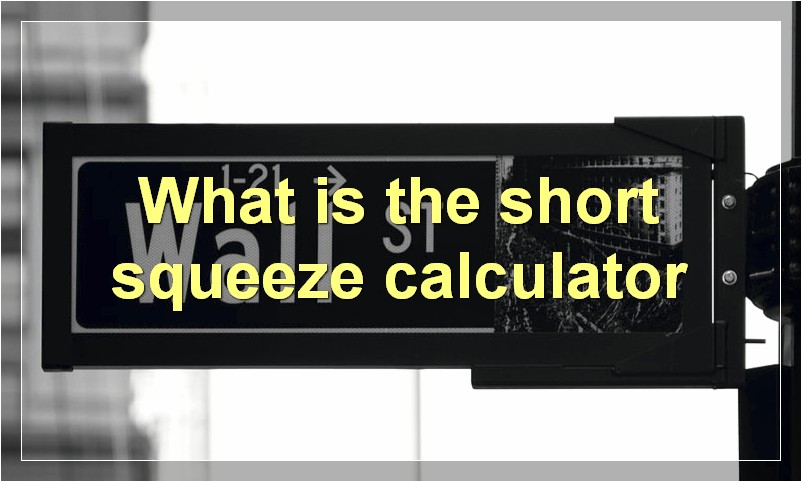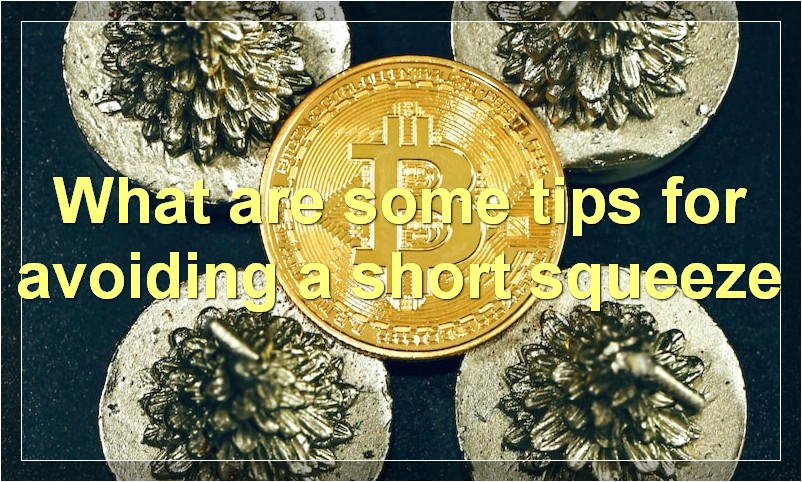If you’re looking to make a quick profit, a short squeeze is the perfect opportunity. And with our new short squeeze calculator, it’s easier than ever to take advantage of this market phenomenon.
What is a short squeeze
A short squeeze is when a stock price jumps sharply higher, forcing investors who bet against the stock to buy it at any cost to cover their losing positions. This buying pressure can push the stock even higher, leading to massive profits for investors who were long the stock.
Short squeezes are often caused by a sudden change in sentiment or an unexpected piece of good news about a company. For example, if a company unexpectedly reports strong earnings, investors who were betting against the stock will be forced to buy it to avoid even bigger losses.
If you’re considering buying a stock that has recently soared on news, it’s important to do your own research before investing. While a short squeeze can lead to quick profits, there’s also the potential for a sharp reversal if the underlying news turns out to be false or overblown.
What is the short squeeze calculator

The short squeeze calculator is a simple tool that allows investors to calculate the potential return on investment for a short squeeze play. A short squeeze occurs when a stock price rises sharply, forcing shorts to buy back shares at a higher price to avoid further losses. The resulting buying pressure can push the stock price even higher, leading to profits for those who were positioned for the move.
The short squeeze calculator takes into account the number of shares shorted, the current stock price, and the target price at which shorts will be forced to buy back shares. It then calculates the potential return on investment based on these factors.
For example, let’s say that XYZ Corporation is currently trading at $10 per share and there are 1 million shares shorted. The stock has a target price of $15, at which point shorts will be forced to buy back their shares. Using the short squeeze calculator, we can see that the potential return on investment for this play is 50%.
While the short squeeze calculator is a useful tool, it is important to remember that there are no guaranteed profits in the stock market. Short squeezes can be difficult to predict and timing is often crucial. Nevertheless, the short squeeze calculator can be a helpful tool for investors who are looking for potential profit opportunities in the market.
How does the short squeeze calculator work
The short squeeze calculator is a tool that is used by investors to determine if a stock is overvalued or undervalued. The calculator takes into account the current price of the stock, the number of shares outstanding, and the number of days to cover. The short squeeze calculator then uses this information to determine if there is a potential for a short squeeze.
What is the difference between a long and a short squeeze
A long squeeze is when a trader buys a security with the hope that it will increase in value and then sells it at a profit. A short squeeze is when a trader borrows a security, sells it, and then repurchases the security at a lower price to return it to the lender.
How can I use the short squeeze calculator to my advantage
When trading stocks, it is important to be aware of all the different forces that can affect the price. One of these forces is known as a “short squeeze.” A short squeeze occurs when there is a sudden increase in the price of a stock that has been heavily shorted. This can happen for a variety of reasons, but most often it is due to positive news about the company that causes investors to buy up the stock.
If you are holding a short position in a stock that experiences a short squeeze, it is important to know how to calculate your potential losses. The short squeeze calculator on our website can help you do this. Simply enter in the number of shares you are short, the current stock price, and the percentage increase in the stock price. The calculator will then show you how much money you could lose if the stock price increases by that amount.
While a short squeeze can be painful for those who are caught on the wrong side of it, it can also present a great opportunity for those who are prepared. If you think a short squeeze is likely to occur, you can use the calculator to help you determine how much of a position you should take. This way, you can maximize your profits while still limiting your risk.
What are some tips for avoiding a short squeeze

A short squeeze happens when a stock price rises sharply, causing short sellers to buy back their shares to avoid losses. This can lead to even higher prices and more profits for investors who are long the stock. Here are some tips to avoid getting caught in a short squeeze:
-Pay attention to stocks with high short interest. A high level of short interest means there are more people betting against the stock, so it may be more volatile.
-Avoid stocks with low float. A low float means there are fewer shares available to trade, so it may be harder to exit your position if the stock price starts to rise.
-Don’t get too attached to your positions. If a stock starts to move against you, be willing to cut your losses and move on.
-Stay disciplined with your stop losses. A stop loss is an order to sell a security when it reaches a certain price, and it can help you limit your losses if a stock price starts to rise too quickly.
What are some common traps during a short squeeze
A short squeeze is when a stock price increases sharply, and short sellers are forced to buy the stock at a higher price to cover their positions. This can be a trap for investors who are not aware of the risks.
Some common traps during a short squeeze include:
1. Not knowing when to exit: A short squeeze can last for days or even weeks, and if you’re not paying attention, you could get trapped in a losing position. Make sure you know when to take profits and cut losses.
2. Falling for false rumors: There’s always a lot of speculation during a short squeeze, and it can be easy to get caught up in the hype. Stick to the facts and don’t let your emotions influence your trading decisions.
3. Chasing the price: It’s tempting to try to jump in on a short squeeze as it’s happening, but this can be a risky move. The price could continue to rise or it could suddenly drop, leaving you with losses.
4. Failing to account for fees: When you’re buying or selling stocks, you need to factor in commissions and other fees. These can eat into your profits or increase your losses, so make sure you take them into account before making any trades.
5. Not having a plan: A short squeeze can be a chaotic and hectic time, so it’s important to have a plan before things get started. Know what stocks you want to buy or sell, and set clear limits on how much you’re willing to lose or gain. This will help you stay calm and focused when the markets are volatile.
How can I tell if I’m in a short squeeze
If you’re wondering how to tell if you’re in a short squeeze, there are a few things you can look for. First, check to see if the stock price is rising rapidly and/or if there is high volume trading activity. If so, this could be an indication that a short squeeze is taking place. Another thing to look for is if there is a sudden increase in the number of shares being traded. This could also be an indication of a short squeeze. Finally, you can also look for news stories or rumors about a particular stock to see if there is anything that could be triggering a short squeeze.
What are the consequences of being in a short squeeze
When a stock is in a short squeeze, it means that there are more investors who want to buy the stock than there are willing sellers. This can happen because the stock price has risen rapidly and short-sellers are forced to buy back the stock to avoid losing money. The result is a sharp increase in the stock price, which can squeeze out long-term investors who may have bought the stock at a higher price. While a short squeeze can be profitable for investors who are able to time it correctly, it can also lead to losses if the stock price falls after the squeeze.
Can the short squeeze calculator help me avoid a short squeeze
If you’re worried about getting caught in a short squeeze, the best thing to do is use a short squeeze calculator. This handy tool can help you determine the risk of a short squeeze happening, and how much it could potentially cost you. By inputting your stock information and the number of shorted shares, the calculator will give you an estimated chance of a short squeeze occurring.

